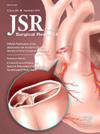A Comparative Analysis of Zip Code Discordance in Pediatric Gunshot Wounds
IF 1.8
3区 医学
Q2 SURGERY
引用次数: 0
Abstract
Introduction
With the rate of pediatric gun violence rising, it is imperative to investigate current trauma intervention strategies. For example, previous trauma studies have used zip codes of residence as a proxy for the zip code of injury. This study aims to look at relationships between zip codes of injury and residence specifically in pediatric patients with gunshot wounds.
Methods
A retrospective review was performed on two trauma registries: one children's hospital and one primary adult hospital in an urban city. Pediatric patients <15 y old with a gunshot wound from January 2016 to April 2023 were included. Zip code discordance (ZCD) was defined as the patient's zip code of injury differing from their zip code of residence; associations between ZCD and clinical variables were analyzed.
Results
Of the 238 patients included in this study, ZCD was observed in 40.3% of patients. Overall, there was a predominance of non-Hispanic, Black males; however, there were significantly more Black patients with ZCD (92.7% versus 79.6%, P = 0.02). Adjusted analysis revealed that ZCD was associated with a longer hospital length of stay (odds ratio 1.41, 95% confidence interval 1.19-1.67, P < 0.01) and a higher likelihood of mortality (odds ratio 6.79, 95% confidence interval 2.39-23.1, P < 0.01).
Conclusions
These findings reveal differences between pediatric patients with and without ZCD, emphasizing the importance of accurate zip code reporting. Future studies should investigate why the associations between ZCD and clinical outcomes occurred.
小儿枪伤中邮政编码不一致的比较分析。
导言:随着小儿枪支暴力事件的增加,研究当前的创伤干预策略势在必行。例如,以前的创伤研究使用居住地的邮政编码来代替受伤地的邮政编码。本研究旨在调查受伤邮政编码与居住地之间的关系,特别是在儿科枪伤患者中的关系:方法:对两个创伤登记处进行了回顾性审查:一个是儿童医院,另一个是城市中的主要成人医院。儿科患者本研究共纳入 238 名患者,其中 40.3% 的患者出现 ZCD。总体而言,非西班牙裔的黑人男性居多;但是,患有 ZCD 的黑人患者明显较多(92.7% 对 79.6%,P = 0.02)。调整后的分析表明,ZCD 与较长的住院时间有关(几率比 1.41,95% 置信区间 1.19-1.67,P 结论:ZCD 与较长的住院时间有关:这些发现揭示了有 ZCD 和没有 ZCD 的儿科患者之间的差异,强调了准确报告邮政编码的重要性。未来的研究应探讨为什么会出现 ZCD 与临床结果之间的关联。
本文章由计算机程序翻译,如有差异,请以英文原文为准。
求助全文
约1分钟内获得全文
求助全文
来源期刊
CiteScore
3.90
自引率
4.50%
发文量
627
审稿时长
138 days
期刊介绍:
The Journal of Surgical Research: Clinical and Laboratory Investigation publishes original articles concerned with clinical and laboratory investigations relevant to surgical practice and teaching. The journal emphasizes reports of clinical investigations or fundamental research bearing directly on surgical management that will be of general interest to a broad range of surgeons and surgical researchers. The articles presented need not have been the products of surgeons or of surgical laboratories.
The Journal of Surgical Research also features review articles and special articles relating to educational, research, or social issues of interest to the academic surgical community.

 求助内容:
求助内容: 应助结果提醒方式:
应助结果提醒方式:


